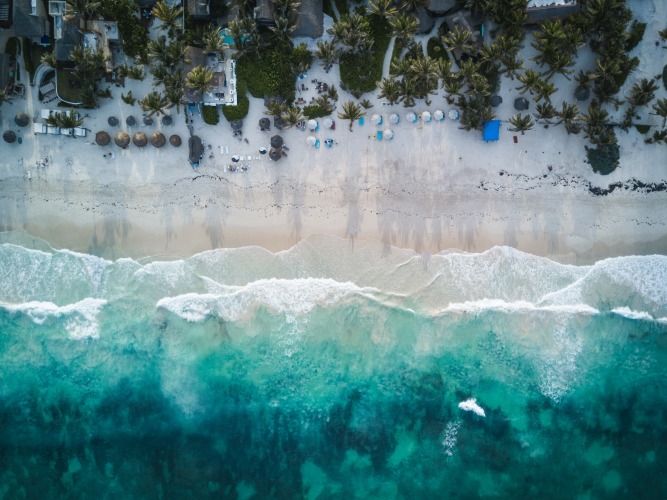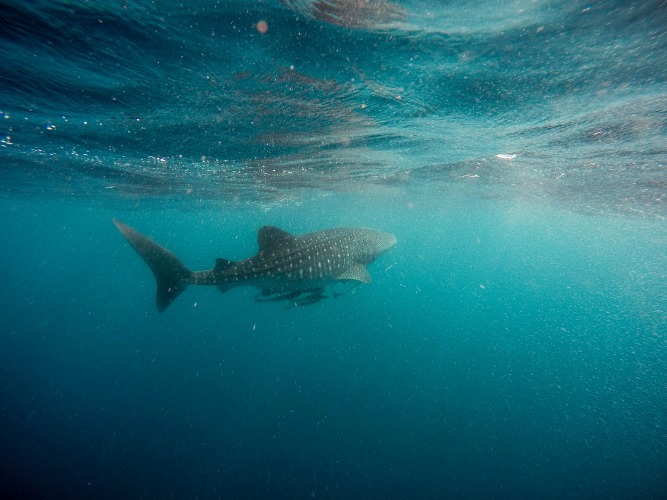Mexico has popular beaches in Acapulco, Cancun, and other locations.
However, what about sharks in the water?
Contents
So… Are There Sharks in Mexico?
Apparently, one of the hotspots for sharks is in Cancun.
They often swim in the Riviera Maya about 89 miles from Cancun too, and you may spot them in Guadalupe Island waters.
In Cancun, sharks seem to congregate in the Quintana Roo region.
Guerrero and Veracruz also have seen their share of sharks.
In April 2022, Nicky Hoseck of the Dutch Shark Society provided an update from the University of Quintana Roo.
At this time, researchers shared their discovery of 85 different shark and ray species in this area.

Cancun seems to contain a majority of the shark species.
However, it’s not the primary place to find Great White Sharks.
Cancun often has seven popular species swimming within its borders.
Great White
I’d go to Guadalupe Island if I were you to find Great White Sharks instead of Cancun.
This volcanic spot also features Great White Shark cage diving tours.
You may want to try exploring underwater during the months of August to November.
That’s when you might see the Great Whites in Guadalupe.
The maximum Great White length extends to about 20 feet, according to the Smithsonian Ocean.
The males grow an average of 11-13 feet, which surprised me because most male animals are larger than females.
In this case, the female grows an average of 15-16 feet.
Whale Shark
Adult whale sharks extend to 32 feet.
Can you imagine?
That’s a little more than five humans measuring six feet tall each.
What amazes me more than that, however, is that they can weigh 20,000 pounds.
That’s more than what four average-sized cars weigh.
Bull
Bull sharks show up in the Gulf of Mexico and the Caribbean Sea near Cancun.
However, you’ll also find them in the Mississippi River and other inland waters, not always near ocean beaches.
Unlike most sharks, they can tolerate both freshwater and saltwater conditions.
The bull shark has a reputation for showing the most aggression.
It’s also considered one of the most dangerous, and it can cause near-fatal injuries if not death.
They grow an average of about 7-11 feet and weigh about 200-500 pounds.
Caribbean Reef
The Caribbean Reef shark is one of its kind that shows up the most often in Cancun.
It’s not thought of as dangerous as the bull shark, but it has attacked people.
The Caribbean Reef shark prefers to hang around coral reefs.
It’s one you’ll see most if you go snorkeling, and it offers attack warning signs, such as arching its back, weaving or spiraling with its head up, or lowering one of its fins.
The Caribbean Reef grows to about nine feet long.
It’s sometimes confused with the silky and dusky sharks, but it’s a requiem shark (prefers brackish or freshwater instead of pure saltwater).
Lemon
Lemon sharks show up more often in Caribbean waters than other types of this animal.
You’ll see it in most Mexican waters.
It reportedly doesn’t show up much in Baja, California like other sharks might.
The maximum lemon shark length is about 10.5 feet.
They may grow an average of about 8 feet and may live about 27 or more years.
They weigh up to 551 pounds.
Mako
It’s amazing how much a Mako shark can weigh for their size – up to 1200 pounds but only about 12 feet long.
They don’t have as much of a reputation as being aggressive, with only one fatal attack in about 450 years.
Nurse
Divers in the Riviera Maya area will frequently see nurse sharks.
I found out that it’s an excellent photo opportunity, but it’s probably not fun for them to be caged up for tourism’s sake.
Nurse sharks don’t move around much.
They prefer to stay on the ocean floor, and they usually only eat small fish and crustaceans.
Hammerhead
Hammerheads rarely pose a threat to humans.
Since the 1500s, only 16 non-fatal attacks have ever occurred.
They’re an endangered species that can grow up to 20 feet, reaching an average of 13-15 feet long, depending on the type.
Some hammerheads only grow to about six to eight feet though.
The larger hammerheads (13-foot-long) weigh about 500 pounds, and the smaller (scalloped) ones put on about 80 to 100 pounds.
Is it Safe to Swim in Mexico?
If a beach is unsafe to swim in Mexico, it’s not normally because of sharks, although they do exist here.
Water quality remains a higher concern than shark attacks in this country.
For example, Rebecca Ann Hughes said in April 2022 that three popular Mexico beaches failed cleanliness tests.
At this time, Manzanillo, Hornos, and Suave beaches in Acapulco had more than 200 bacterial units in them per 100 milliliters of water.
The 200 to 100 ratio is what’s allowed by the World Health Organization, and the type of bacteria found on these beaches is called enterococcus faecalis.
This pathogen resides in the gastrointestinal tract and causes infections in humans.
As of April 2022, bacterial readings indicated that these waters are unsafe for swimming.
This can change, however.
Make sure you read local beach reports of the areas where you plan to swim.
You never know when it could change for the good or the bad.
If you’re not sure where to find information, start by reading annual water quality reports.
It also provides what to expect about drinking Mexican water, which usually is not recommended.
You also will want to pay attention to reports about river water quality and heed the warning signs.
Interesting Shark Facts in Mexico
Large Shark Eats Smallest Foods
I find it ironic that the whale shark is one of the largest of its species, and eats the smallest foods.
Its filtering system only allows it to eat tiny plankton and small shrimp or other small crustaceans and fish.
The whale shark also has to open its mouth about four feet to swallow its “dinner.”
Their gills process about 6,000 liters of water per hour, which equals about 13,200 fluid pounds.
WWF publishes these and other whale shark facts you may want to read.
Other sharks eat larger fish, and they even eat mammals that live in the sea.
Some of them may also eat turtles and snakes.
Why Human Attacks Occur
Some of the attacks against humans are by mistake.
That’s why you shouldn’t swim in the dark.
They have poor eyesight and might think you’re another animal not a person.
Sharks also sometimes end up startled.
For instance, a diver may get too close to one and scare it.
They may not always attack though.
In fact, Florida Program for Shark Research Director Gavin Naylor says that sharks usually ignore people.
Naylor also says that people would be surprised how often they were in the water with sharks.
They’re not always visible on the surface, and some of them stay closer to the ocean floor thousands of feet below sea level though.
Others might come up occasionally.
In some cases, sharks are provoked by people.
This happens indirectly during harvesting or maybe during a boat accident.
It’s almost never because a human wants to tease a shark though, because who would want to?

Types of Sharks That Attack
Only three sharks out of the hundreds that live in the water are the most aggressive toward humans.
The Great White, Bull, and Tiger sharks attack the most.
Some sources say that up to six species of sharks can live in freshwater.
However, I only know of two, and the bull shark is one of them that you would find in Mexico.
Sharks typically prefer water about 70 degrees (60-80 degree range).
The bull shark is found inland more than others prevalent in Mexico because its respiratory system allows it to reside in freshwater.
Most other sharks can only stay in freshwater for maybe a few hours to a few days.
They usually only enter lakes, streams, rivers, or other non-ocean waters looking for food.
Otherwise, they may have traveled a little too far from their normal jurisdiction.
3 Safety Tips for Swimming in Shark-infested Waters
1. Don’t ignore the “no swimming” signs.
I know. It’s human nature ever since we existed on this earth.
When we’re told not to do something, that makes us want to do it more.
There are consequences – usually dangerous ones – for swimming in places where it says not to.
Usually, “no swimming” signs are up because the water is too contaminated, but it could occasionally be because of shark infestations.
High tides might also be another reason for swimming prohibitions, so just don’t swim there.
2. Don’t go into the water before dawn or after dark.
Early in the morning and right about sundown, which is “dinner time,” is not the best time to go into the water.
Swim in broad daylight when sharks can see better.
They don’t see well in the dark and may mistake you for another animal they plan to eat.
3. Don’t provoke or feed sharks.
Most shark attacks are accidents, but some of them happen because of intentional provocation.
Don’t ever tease, aggravate or taunt a shark.
It will provoke them.
Don’t ever feed sharks in the wild fish scraps or other food while out on the beach either.
Summary
Sharks do exist in Mexico.
It’s not likely to be your top concern when living there though.
Water contamination and tropical storms may occur before a shark attack would.
Frequently Asked Questions
Do Mexico sharks bite people unprovoked?
Spikes of unprovoked shark attacks have occurred around the world as reported in 2016.
In 2015 alone, 98 people were attacked.
It’s rare that fatalities occur though, and if any provocation did occur, it was usually accidental, such as when removing a shark from a fishing hook.
Why is there an increase in shark attacks?
It may be because of increased world human populations.
It makes sense to me because maybe we people are invading their space.
What do sharks eat?
If you’re wondering if they eat humans, not usually.
They typically only attack if startled, which may not have happened intentionally by a human.
Depending on the species, they typically prefer other fish, crustaceans or dolphins, and sea lions.
They also may prefer mollusks, seals, or squid.
How many people die per year in Mexico from shark attacks?
About 35 unprovoked fatal attacks have occurred since 1915.
No fatal provoked attacks occurred since this period as recent as at least 2015.












Sharks do exist in Mexico, but they are not a major concern for swimmers compared to water contamination and tropical storms.
As long as you are aware of the potential risks and take necessary precautions, the beauty and fun of Mexico’s popular beaches outweigh the potential presence of sharks.
Yes, but they are not a major concern for locals as there are plenty of beautiful beaches to enjoy.